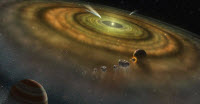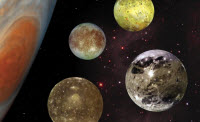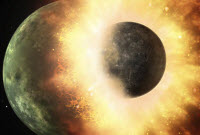In our Solar System we find to kinds of planets: small rocky planets closer to the sun, and ice giants further out. The rocky planets (Mercury, Venus, Earth and Mars) have only three moons among them, whereas the ice giants (Jupiter, Saturn, Uranus and Saturn) have around ninety.
 For the reason, we need to look back to the formation of the Solar System, from a giant, swirling cloud which collapsed under its own gravitational mass. As the cloud contracted, it heated-up and started to rotate faster, resulting in a proto-planetary disk hot, gas and dust rotating around a mass at its centre. The central mass, of course, became the sun; but the rest didn't immediately have the circumstances for gravity to pull together. It needed some seed.
For the reason, we need to look back to the formation of the Solar System, from a giant, swirling cloud which collapsed under its own gravitational mass. As the cloud contracted, it heated-up and started to rotate faster, resulting in a proto-planetary disk hot, gas and dust rotating around a mass at its centre. The central mass, of course, became the sun; but the rest didn't immediately have the circumstances for gravity to pull together. It needed some seed.
Near the sun, the temperature was so high that all the material was gas and couldn't form planets. A little further out there were metal flakes and fragments, and small pieces of rock; which stuck together when they collided, eventually becoming big enough to gravitationally attract matter to them, at which point we call them 'planetesimals'. They grew quickly up to the point when collisions started to break them apart. Only the largest objects survived to become the inner planets.
 Outside the orbit of Mars, the temperature was low enough for ice to form in addition to the flakes and fragments. This meant more and better seeds which helped them to grow even faster. After a certain size they were able to hold on to hydrogen and helium which was abundant in the proto-planetary disk; so much so that each became something like a tiny solar system in its own right. That's how the majority of moons formed around the ice giants.
Outside the orbit of Mars, the temperature was low enough for ice to form in addition to the flakes and fragments. This meant more and better seeds which helped them to grow even faster. After a certain size they were able to hold on to hydrogen and helium which was abundant in the proto-planetary disk; so much so that each became something like a tiny solar system in its own right. That's how the majority of moons formed around the ice giants.
Between Mars and Jupiter is the asteroid belt, containing many planetesimals which failed to coalesce into planets or journey into the inner solar system because of the disruptive gravitational effects of massive Jupiter. Although it's thought that the two moons of Mars (Phobos and Deimos) are two such planetesimals which have been captured into orbit.
 So then what of our own Moon? This is thought to have started out as a large planetesimal around the size of Mars, which smacked into the earth in the early solar system. The collision would have ejected so much material into earth's orbit that it eventually coalesced into a ring, and then into the Moon.
So then what of our own Moon? This is thought to have started out as a large planetesimal around the size of Mars, which smacked into the earth in the early solar system. The collision would have ejected so much material into earth's orbit that it eventually coalesced into a ring, and then into the Moon.
So in the end, we probably have just one Moon because there wasn't enough material in the inner solar system to create any more than just one, and because Jupiter tends to stop other potential moons entering the inner solar system.
The video and material for this article was made by UK Astrophysicist Sebastian
Pines, creator of the 'Astronomic' YouTube channel. You can support Seb's work creating videos that help to teach the world about astronomy by sponsoring a dollar or two per month via his Patreon page.
- Log in to post comments


